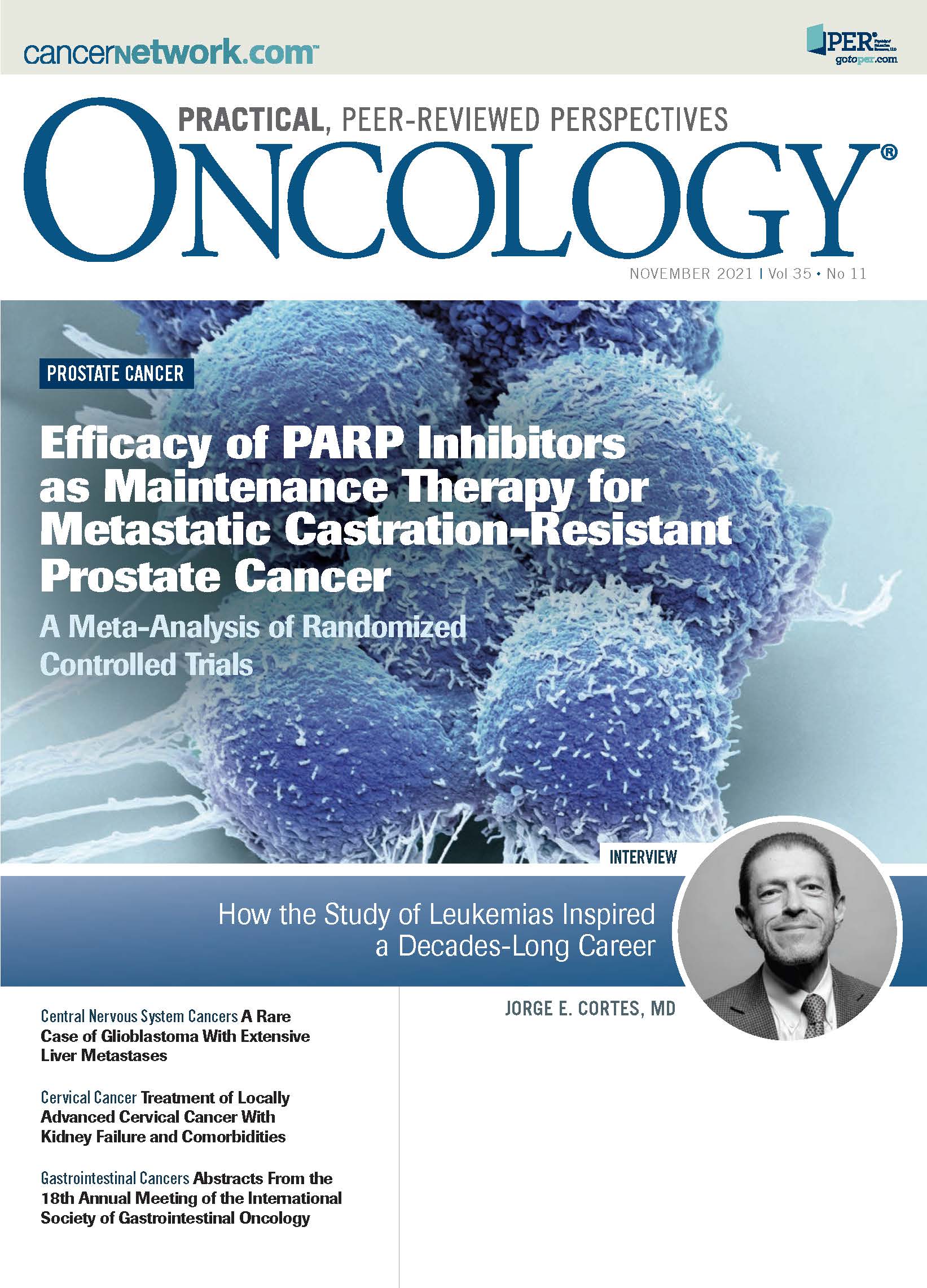Expert Commentary on the Product Profile of Tepotinib
In an interview with ONCOLOGY®, David Hughes PharmD, BCOP, and Jessica Freydman, PharmD, offers a comprehensive review of real-world treatment considerations of tepotinib as therapy for patients with metastatic non–small cell lung cancer that have MET exon14 skipping mutations.
David Hughes, PharmD, BCOP
Clinical Pharmacy Manager of Oncology and Specialty Programs Boston Medical Center Boston, MA

ONCOLOGY®: Can you describe the mechanism of action of tepotinib?
Freydman:[Tepotinib] is a MET kinase inhibitor. The MET kinase has downstream signaling through the RAS and the RAF pathways and the PI3K pathway, and an overexpression of this [MET kinase] leads to cell proliferation and survival. Losing exon 14 in this MET kinase deletes the spot on the juxta-membrane, which leads to decreased ubiquitination, which then leads to increased expression of MET. If you have too much MET [expression], then you have too much cell proliferation and survival. Tepotinib is approved for the [MET] exon 14 skipping mutation, which then causes the overexpression.
Hughes:Another interesting point is that when we think about MET as a whole, most people think of a biomarker-based or precision-based strategy [where] a patient is diagnosed with metastatic [disease] and then a MET mutation or amplification comes up. To frame it, there are 2 different variants: the MET exon 14 skipping mutation seen in about 2% to 3% of adenocarcinoma lung cancer, and the amplifications that occur within that cohort.
The other interesting piece with MET is that it’s been identified as a secondary mutation or acquired resistance to pressure. Several studies have evaluated that when you pressure patients who are on EGFR inhibitors—drugs like osimertinib [Tagrisso] and others—you can see MET amplification as one of the resistance mechanisms to that. It highlights another unique niche area to really focus in on and see how we can incorporate it into the landscape of lung cancer.
Q: What are some of the biggest concerns with the toxicity profile? Have any new safety concerns been made more apparent in the real-world setting?
Freydman:The adverse events [AEs] that are seen from tepotinib are from the VISION trial [NCT02864992]. In this trial, treatment-related AEs happened in about 90% of patients, the most common of which was peripheral edema as seen in about 60%. This was followed by nausea and diarrhea, both [of which] were [found] in about a fifth of the patients. It was almost entirely grade 1 and 2 [events of] diarrhea and vomiting. Grade 3 and 4 AEs were present in about 30% and again, they were mostly [events of] peripheral edema. A few incidences of pleural effusion occurred, in about 3% of the patients. There wasn’t commonly increased lipase, alanine aminotransferase, or aspartate aminotransferase, but [when they did occur, they] were asymptomatic. Mechanistically, this does make sense because one of the ligands for MET is the hepatocyte growth factor, and as tepotinib inhibits the MET, this mechanism would support seeing some [hepatic events].
Hughes:We have 2 different MET inhibitors available, and I’ll allude to some of the differences throughout; we have capmatinib [Tabrecta]4 and tepotinib. Clinically in the real world, edema is a real AE we see with these drugs. It’s something that has come up more commonly than not and [can] even require some dosing modifications.
You do you see higher peak [concentration] with tepotinib, so you can see some higher rates of nausea and vomiting comparatively when you look numerically at the 2 [agents] side by side. I’m not necessarily saying one is worse than the other, but when you think about structural differences in pharmacokinetics, I think it makes sense for us, being pharmacists, to recognize the pathogenesis [behind] the hepatotoxicity we see. It’s interesting that it’s due to the hepatocyte growth factor. These are all very common; we see them in clinical practice [and we saw them] in the VISION trial.
Jessica Freydman, PharmD
Pharmacy Resident
Boston Medical Center Boston, MA

Q: Are any dosing modifications common with this agent?
Freydman:The recommended dose is 450 mg orally once daily. I want to note that the VISION trial, which is the biggest trial, did report on using 500 mg of tepotinib. This was the hydrochloride hydrate formulation, which is equivalent to the 450 mg that we see commercially. The dose reduction as recommended is going down to 225 mg, and then patients who can’t tolerate the once-daily 225 mg [dose] should permanently discontinue the medication. Dose reductions occurred in about a third of the patients in the trial, but it was only permanently discontinued in 10% of those patients. The most common reason for a dose reduction was the peripheral edema.
Hughes:When you think about dosing modifications and adherence, I continuously contrast [tepotinib] with capmatinib. We have a once-daily drug [with tepotinib] vs a twice-daily drug [with capmatinib]. So again, I think some of these things are important to think about.
Q: Should clinicians be aware of any drug interactions?
Freydman:Tepotinib does have to be taken with food. As far as drug interactions, it does interact with CYP3A [inducers] and PGP [P-glycoprotein]. It should be avoided with inducers of CYP3A such as rifampin, penicillin, or phenobarbital, and with the medications that have dual CYP3A and PGP inhibition, such as azole antifungals or HIV protease inhibitors. Another thing to watch out for is drugs that are PGP substrates with a narrow therapeutic index. For example, digoxin does have a dose reduction that’s recommended if you’re going to start your patient on tepotinib. Another one to watch out for is dabigatran, because the area under the curve usually does increase by about 50%.
Q: Have any barriers to administrations or receipt by the patient emerged since this agent’s approval, such as common reimbursement issues or logistical challenges?
Hughes: The biggest aspect here is coverage, regardless of the [availability of a]
plethora of drugs in the lung cancer space. Most of the targeted therapies are not a $5-to-$6 fill per month an more—they’re about $10,000-plus a month. As you get more rare mutations that come up like MET, that cost goes up. Obviously, the first challenge is [whether] the patient can afford the drug. Many different assistance programs or commercial co-pay cards exist for patients who may have primary insurance and need co-pay assistance. Then you have the percentage of patients, such as [those with] Medicare, who have very high co-pays; [in those cases, we can] look to resources like chronic disease funds, patient assistance programs, or different manufacturers to find ways to get the patient on the drug.
On top of just the financial piece, certain insurances or payers may have restrictions [regarding] one [MET inhibitor] vs the other. In clinical practice, when asking, ‘What am I going to do for my individual patient?’, it’s really imperative to know what the differences are and to use your knowledge base of pharmacy and payers to know if a provider or a payer will restrict capmatinib over tepotinib or if tepotinib will be the preferred agent, aside from some of the differences that we’ve seen above. I think reimbursement can become an issue, but I think it’s [interesting] because if a patient does have a MET driver mutation, you won’t see issues from a prior authorization perspective or financial incentive, at least up front.
Q: Would you like to add anything else?
Freydman: I want to stress the importance of doing next-generation sequencing and focusing on that targeted therapy for non–small cell lung cancer. There is utility of doing this both at diagnosis and then if the patient progresses or develops resistance. You may have some resistance patterns that can be targeted with these medications. Again, [let’s] go back to the VISION trial: The results were reported based on both liquid biopsy and solid tissue biopsy, which does show that you can utilize both methods for diagnosing patients.
Hughes: We’re in an era of precision-based medicine and biomarker-driven approaches in non–small cell lung cancer. Optimally, when testing patients and in retesting progression, you’re able to unfold some of these mutations and get a better understanding of tumor biology for utilizing both liquid and tissue biopsies that we know separately have their own advantages and challenges.
Overall, as we learn more and more about these biomarker-based strategies, a lot of [concepts that] we talked about [will remain] very useful in clinical practice to take care of our patients.
Financial Disclosure: The authors have no significant financial interest in or other relationship with the manufacturer of any product or provider of any service mentioned in this article.

Reference
1. FDA grants accelerated approval to tepotinib for metastatic non–small cell lung cancer. FDA. February 3, 2021. Accessed October 12, 2021. https://bit.ly/3AAL8NK
2. Tepotinib. Prescribing information. Merck KGaA; 2021. Accessed October 12, 2021. https://bit.ly/3BAWS45
3. Paik PK, Felip E, Veillon R, et al. Tepotinib in non–small-cell lung cancer with MET exon 14 skipping mutations. N Engl J Med. 2020;383(10):931-943. doi:10.1056/NEJMoa2004407
4. Capmatinib. Prescribing information. Novartis; 2021. Accessed October 13, 2021. https://bit.ly/2X8D09DR-21-1566

Newsletter
Stay up to date on recent advances in the multidisciplinary approach to cancer.